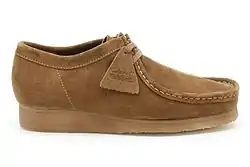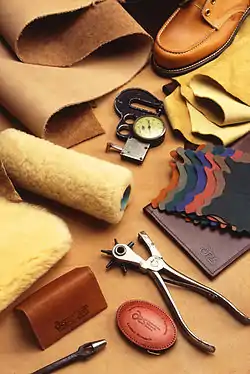Suede
Suede (pronounced /sweɪd/ (SWAYD)) is a type of leather with a napped finish, commonly used for jackets, shoes, shirts, purses, furniture, and other items. The term comes from the French gants de Suède, which literally means "gloves from Sweden".[1]
.jpg.webp)
Suede is made from the underside of the animal skin, which is softer and more pliable than, though not as durable as, the outer skin layer.[2]
Production

Suede leather is made from the underside of the skin, primarily from lamb, although goat, calf and deer are commonly used. Splits from thick hides of cow and deer are also sueded, but, due to the fiber content, have a shaggy nap. Because suede does not include the tough exterior skin layer, suede is less durable but softer than standard ("full-grain") leather. Its softness, thinness, and pliability make it suitable for clothing and delicate uses; suede was originally used for women's gloves, hence its etymology (see above). Suede leather is also popular in upholstery, shoes, bags, and other accessories, and as a lining for other leather products. Due to its textured nature and open pores, suede may become dirty and quickly absorb liquids.
Alternatives
Fabrics are often manufactured with a brushed or napped finish to resemble suede leather. These products often provide a similar look and feel to suede, but have advantages such as increased liquid or stain resistance, and may appeal to consumers who prefer a non-animal product.
Sueded silk, sueded cotton and similar sueded fabrics are brushed, sanded or chemically treated for extra softness. "Suede" yarns are generally thick and plush.
Alcantara and Ultrasuede are trademarked names for a plush microfiber with a feel resembling soft suede, but more durable and resistant to liquids and stains. It can be used in upholstery, accessories, clothing or shoes.
In popular culture
- Suede's absorbent nature was highlighted in the Seinfeld episode "The Jacket", in which Jerry ventures outside into the snow and ruins his exorbitantly priced suede jacket.
- "Blue Suede Shoes" is a well-known early rock-n-roll song written by Carl Perkins and also covered by Elvis Presley.
References
- Suede, Dictionary.com
- "Difference Between Leather and Suede - Explainry". Explainry. Retrieved 2017-02-11.
Further reading
- American Leather Chemists Association ALC (1906). The Journal of the American Leather Chemists Association. American Leather.
- Bredenberg, Jeff (1999). Clean It Fast, Clean It Right: The Ultimate Guide to Making Absolutely Everything You Own Sparkle & Shine (New ed.). Rodale Books. p. 544. ISBN 1-57954-019-8.
- Burch, Monte (2002). The Ultimate Guide to Skinning and Tanning: A Complete Guide to Working with Pelts, Fur, and Leather (First ed.). The Lyons Press. p. 240. ISBN 1-58574-670-3.
- Churchill, James E. (1983). The Complete Book of Tanning Skins and Furs. Stackpole Books. p. 197. ISBN 0-8117-1719-4.
- Goldstein-Lynch, Ellen; Sarah Mullins; Nicole Malone (2004). Making Leather Handbags and Other Stylish Accessories. Quarry Books. p. 128. ISBN 1-59253-076-1.
- Kite, Marion; Roy Thomson (2005). Conservation of Leather and Related Materials. Butterworth-Heinemann. p. 240. ISBN 0-7506-4881-3.
- Michigan Historical Reprint Series (2005). The Art of Tanning Leather. Scholarly Publishing Office, University of Michigan Library. p. 266. ISBN 1-4255-2365-X.
- O'Flaherty, Fred; Roddy Lollar (1956). The Chemistry and Technology of Leather. ACS Monograph 134 (1978 ed.). American Chemical Society, Krieger Publishing Co. ASIN B007EUI5M4.
- Parker, Sybil P (1992). McGraw-Hill Encyclopedia of Science & Technology: An International Reference Work. New York: McGraw-Hill. p. 508. ISBN 0-07-909206-3.
External links
 Media related to Suede at Wikimedia Commons
Media related to Suede at Wikimedia Commons
